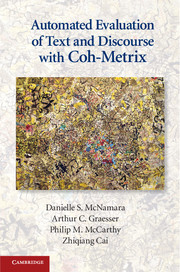Concluding Remarks
Published online by Cambridge University Press: 05 June 2014
Summary
Our hope in this book has been to provide readers with a coherent description of Coh-Metrix and how to make use of it. Coh-Metrix has changed our lives in terms of how we conduct research: from the way we ask questions to the way we answer them. Our understanding of text, including natural language, discourse, and linguistics, has grown exponentially as we have developed Coh-Metrix and explored language using our tools. It has opened doors we never dreamed existed.
To us, Coh-Metrix is like using the Internet. That is, just as we can now type pretty much any question into a search engine and expect to get an actionable answer, so too can we also ask Coh-Metrix to transform our vast quantities of data into output that answers a world of questions about language. But of course, there are certainly limits to Coh-Metrix 3.0. First, although we have explored hundreds of indices in this project, Coh-Metrix 3.0 only includes a subset of these indices. Nonetheless, we have attempted to include what we consider to be the most important and valid indices among the entire array. Second, Coh-Metrix includes a wide variety of indices, but most of these are related to text difficulty, and our particular focus has been on measures related to cohesion. As such, Coh-Metrix cannot answer every question about language. Third, our motto in the Coh-Metrix project has been to explore the “low-hanging fruit.” The indices we provide in Coh-Metrix tend not to involve highly complex computational linguistic algorithms. We have avoided algorithms that are computationally expensive because of the need to process text and provide results relatively quickly. That said, the Coh-Metrix variables that we have included are the potential building blocks of far more sophisticated assessments that we will continue to develop in the next phases of the Coh-Metrix project.
- Type
- Chapter
- Information
- Automated Evaluation of Text and Discourse with Coh-Metrix , pp. 223 - 228Publisher: Cambridge University PressPrint publication year: 2014

